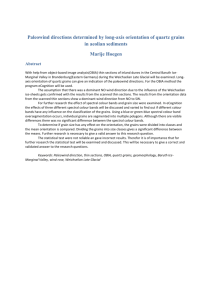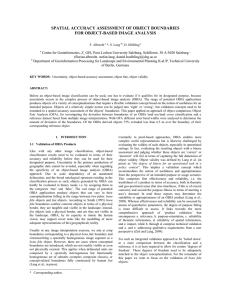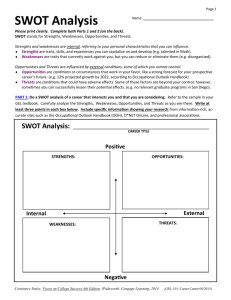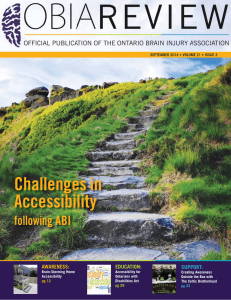strengths, weaknesses, opportunities and threats (SWOT)
advertisement
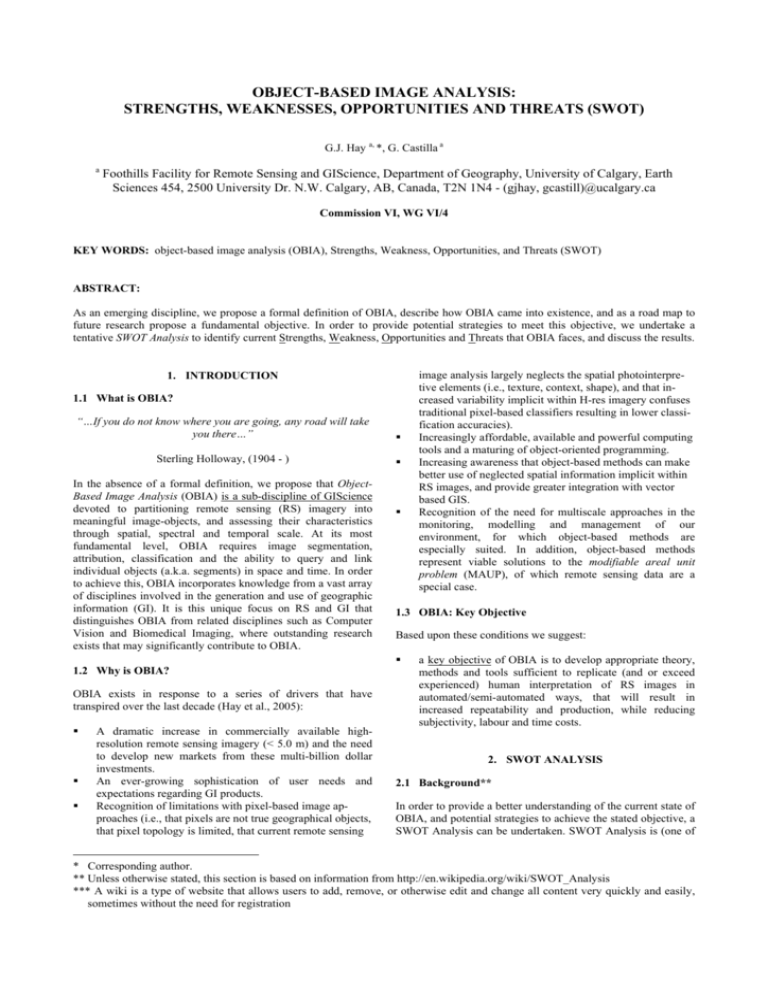
OBJECT-BASED IMAGE ANALYSIS: STRENGTHS, WEAKNESSES, OPPORTUNITIES AND THREATS (SWOT) G.J. Hay a, *, G. Castilla a a Foothills Facility for Remote Sensing and GIScience, Department of Geography, University of Calgary, Earth Sciences 454, 2500 University Dr. N.W. Calgary, AB, Canada, T2N 1N4 - (gjhay, gcastill)@ucalgary.ca Commission VI, WG VI/4 KEY WORDS: object-based image analysis (OBIA), Strengths, Weakness, Opportunities, and Threats (SWOT) ABSTRACT: As an emerging discipline, we propose a formal definition of OBIA, describe how OBIA came into existence, and as a road map to future research propose a fundamental objective. In order to provide potential strategies to meet this objective, we undertake a tentative SWOT Analysis to identify current Strengths, Weakness, Opportunities and Threats that OBIA faces, and discuss the results. 1. INTRODUCTION 1.1 What is OBIA? “…If you do not know where you are going, any road will take you there…” Sterling Holloway, (1904 - ) In the absence of a formal definition, we propose that ObjectBased Image Analysis (OBIA) is a sub-discipline of GIScience devoted to partitioning remote sensing (RS) imagery into meaningful image-objects, and assessing their characteristics through spatial, spectral and temporal scale. At its most fundamental level, OBIA requires image segmentation, attribution, classification and the ability to query and link individual objects (a.k.a. segments) in space and time. In order to achieve this, OBIA incorporates knowledge from a vast array of disciplines involved in the generation and use of geographic information (GI). It is this unique focus on RS and GI that distinguishes OBIA from related disciplines such as Computer Vision and Biomedical Imaging, where outstanding research exists that may significantly contribute to OBIA. 1.3 OBIA: Key Objective Based upon these conditions we suggest: 1.2 Why is OBIA? OBIA exists in response to a series of drivers that have transpired over the last decade (Hay et al., 2005): A dramatic increase in commercially available highresolution remote sensing imagery (< 5.0 m) and the need to develop new markets from these multi-billion dollar investments. An ever-growing sophistication of user needs and expectations regarding GI products. Recognition of limitations with pixel-based image approaches (i.e., that pixels are not true geographical objects, that pixel topology is limited, that current remote sensing image analysis largely neglects the spatial photointerpretive elements (i.e., texture, context, shape), and that increased variability implicit within H-res imagery confuses traditional pixel-based classifiers resulting in lower classification accuracies). Increasingly affordable, available and powerful computing tools and a maturing of object-oriented programming. Increasing awareness that object-based methods can make better use of neglected spatial information implicit within RS images, and provide greater integration with vector based GIS. Recognition of the need for multiscale approaches in the monitoring, modelling and management of our environment, for which object-based methods are especially suited. In addition, object-based methods represent viable solutions to the modifiable areal unit problem (MAUP), of which remote sensing data are a special case. a key objective of OBIA is to develop appropriate theory, methods and tools sufficient to replicate (and or exceed experienced) human interpretation of RS images in automated/semi-automated ways, that will result in increased repeatability and production, while reducing subjectivity, labour and time costs. 2. SWOT ANALYSIS 2.1 Background** In order to provide a better understanding of the current state of OBIA, and potential strategies to achieve the stated objective, a SWOT Analysis can be undertaken. SWOT Analysis is (one of * Corresponding author. ** Unless otherwise stated, this section is based on information from http://en.wikipedia.org/wiki/SWOT_Analysis *** A wiki is a type of website that allows users to add, remove, or otherwise edit and change all content very quickly and easily, sometimes without the need for registration OBIA, 2006: The International Archives of the Photogrammetry, Remote Sensing and Spatial Information Sciences many possible strategic planning tools) used to evaluate the Strengths, Weakness, Opportunities and Threats involved in a project, or any other situation requiring a decision. Consequently, our objective is to apply this method of planning early in the life cycle of OBIA with the intent that concepts described here can be used to strengthen and guide this emerging discipline. The following sections represent a number of SWOTs identified as we considered the past, present and future of OBIA. They are by no means the only possible items, and in several cases – depending on one’s perspective – individual items could exist in more than one category. 2.2 OBIA Strengths In practice, once an objective has been established, a multidisciplinary team representing a broad range of perspectives should carry out SWOT analysis; which is typically presented in the form of a matrix (Table 1). Thus, we invite interested individuals to participate immediately following this presentation, and or to contact the author with comments by email. Ideally we envision the creation of a Wiki*** to facilitate further discussion and development. Internal (attributes of the organisation) External (attributes of the environment) Helpful to achieving the objective Harmful to achieving the objective Strengths Weaknesses Opportunities Threats Table 1. SWOT matrix (adapted from Winer, 2006) SWOTs are defined based on the following criteria: Strengths are internal attributes of the organization that are helpful to the achievement of the objective. Weaknesses are internal attributes of the organization that are harmful to the achievement of the objective. Opportunities are external conditions that are helpful to the achievement of the objective. Threats are external conditions that are harmful to the achievement of the objective. 2.3 OBIA Weaknesses In theory, SWOTs are used as inputs to the creative generation of possible strategies, by asking and answering the following four questions numerous times: How can we Use each Strength? How can we Stop each Weakness? How can we Exploit each Opportunity? How can we Defend against each Threat? To reap the full benefits of SWOT analysis it is important to use this tool correctly. Firstly, the analysis should provide information that helps in decision making. Consequently, laundry-lists of strengths, weaknesses, etc are not in themselves very useful. It is only when the potential implications of this information on the organization/discipline are assessed that meaningful analysis emerges. Secondly, it is most beneficial to look at the strengths and weaknesses originating within (i.e., internal to) the discipline or organization. For example, what do we do better than anyone else, what/where could we improve, what are others likely to see as weakness? Conversely, opportunities and threats should be externally focused i.e., what trends could you take advantage of, how can you turn your strengths into opportunities, what trends could do you harm? (MindTools, 2006). Partitioning an image into objects is akin to the way humans conceptually organize the landscape to comprehend it. Using image-objects as basic units reduces computational classifier load by orders of magnitude, and at the same time enables the user to take advantage of more complex techniques (e.g. non-parametric). Image-objects exhibit useful features (e.g. shape, texture, context relations with other objects) that single pixels lack. Image-objects are less sensitive to MAUP (Openshaw 1984) than units that do not keep a correspondence with the structure of the phenomenon under study. Image-objects can be more readily integrated in vector GIS than pixel-wise classified raster maps. Several OBIA methods/commercial software packages build upon the powerful object-oriented (OO) paradigm. Under the guise of ‘flexibility’ current commercial objectbased software provides overly complicated options. There are numerous challenges involved in processing very large datasets. Even if OBIA is more efficient than pixel-based approaches, segmenting a multispectral image of several tens of mega-pixels is a formidable task (efficient tiling/multiprocessing solutions are necessary). Segmentation is an ill-posed problem, in the sense it has no unique solution, e.g., (i) changing the bit depth of your heterogeneity measure can lead to different segmentations. (ii) Remember, even human photo-interpreters will not delineate exactly the same things. There is a lack of consensus and research on the conceptual foundations of this new paradigm, i.e., on the relationship between image-objects (segments) and landscape objects (patches). For example, (i) what is the basis to believe that segmentation-derived objects are fine representations of landscape structural-functional units? (ii) How do you know when your segmentation is good? (iii) Is there a formally stated and accepted conceptual foundation? There exists a poor understanding of scale and hierarchical relations among objects derived at different resolutions. Do segments at coarse resolutions really ‘emerge’ or ‘evolve’ from the ones at finer resolutions? Should boundaries perfectly overlap (coincide) through scale? Operationally it’s very appealing, but what is the ecological basis for this? 2.4 OBIA Opportunities Object-Oriented concepts and methods have been successfully applied to many different problems, not only computer languages, and they can be easily adapted to OBIA. This integration not only includes OO programming, but all the corpus of methods and techniques customarily used in biomedical imaging and OBIA, 2006: The International Archives of the Photogrammetry, Remote Sensing and Spatial Information Sciences computer vision that remain unknown to most of the remote sensing community. While further research is needed, interesting integrative object-based proposals already exist that offers ontological foundations (Castilla 2003). There are new IT tools (e.g. wikis) that may accelerate consensus and cohesion of OBIA. There is a steadily growing community of RS/GIS practitioners that currently use image segmentation for different GI applications. Thus, as OBIA matures, new commercial/research opportunities will exist to tailor object-based solutions for specific fields, disciplines and user needs i.e., forestry, habitat mapping, urban mapping, mineral exploration, transportation, security, etc. Symmetric multiprocessing, parallel processing and grid computing are recent technologies that OBIA methods may build upon to tackle problems related to the analysis of large datasets. 2.5 OBIA Threats OBIA is far from been an operationally established paradigm, yet many users of commercial OBIA software do not recognize this fundamental fact. OBIA is not one specific research or commercial software. Much remains to be solved. Trying to make distinct OBIA from other OO concepts and methods (e.g. by using ‘based’ instead of ‘oriented’) may contribute to insulation (of users in an esoteric world of ‘objects’) and isolation (of the concept) rather than to consolidation. The visual appeal of image-objects, their easy GISintegration and the enhanced classification possibilities have attracted the attention of major RS image processing vendors, who are increasingly incorporating new segmentation tools into their packages. This provides a wider choice for practitioners, but promotes confusion (among different packages, options, syntax, etc) and makes it more difficult to reach a consensus on what OBIA is all about. Will a lack of protocols, formats, and standards lead to a segmentation of the field rather than a consolidation? 3. DISCUSSION AND CONCLUSION The objective of this paper has been to provide an early attempt at formally defining Object-Based Image Analysis (OBIA), outlining a key objective of this new field, and identifying a number of Strengths, Weakness, Opportunities and Threats (SWOT) that OBIA faces, with the intent that items described here can be used to strengthen and guide this promising new field. We suggest that a key issue faced by OBIA will be to ensure that an integrative, well understood, and easily defined ontology is developed and integrated within the research and commercial software that is being developed for object-based image analysis. As a sub-discipline of GIScience, we suggest that this ontology can draw upon the strong theoretical and application based components that already exist in the established fields of remote sensing, image processing, computer vision, computer science, and landscape ecology. We propose that a way to achieve this is by developing a living document – an OBIA guide book - to which practitioners can turn to for understanding and direction. We also propose that Wikis may be the ideal vehicle to develop such a device. As such, we cordially invite interested parties to contact the author so that this project may be initiated and developed from a user community and scientific perspective, rather than solely from commercial drivers. 3.1 ACKNOWLEDGEMENTS We express our appreciation to Thomas Blaschke, Stefan Lang, Elisabeth Schöpfer, and the other members of the organization committee for their efforts in developing and hosting the 1st International Conference on Object-based Image Analysis, and look forward to future generations of this conference. This research has been generously supported in part by a University of Calgary Start-up Grant, and an Alberta Ingenuity New Faculty Grant to Dr Hay. The opinions expressed here are those of the Authors, and do not necessarily reflect the views of their funding agencies. 4. REFERENCES Castilla, G., 2003. Object-oriented analysis of Remote Sensing images for land cover mapping: conceptual foundations and a segmentation method to derive a baseline partition for classification. Ph.D. Thesis, Polytechnic University of Madrid. http://www.montes.upm.es/Servicios/biblioteca/tesis/GCastilla TD_Montes.pdf (accessed 23 June, 2006) Hay, G.J., Castilla, G., M. Wulder, M.A., and Ruiz, J.R., 2005. An automated object-based approach for the multiscale image segmentation of forest scenes. International Journal of Applied Earth Observation and Geoinformation, 7, pp 339-359. MindTools, 2006. www.mindtools.com, (accessed 23 June, 2006) Openshaw, S., 1984. The Modifiable Areal Unit Problem, In: Concepts and Techniques in Modern Geography (CATMOG), No. 38, 40 p. GeoBooks, Norwich, United Kingdom. Winer, L, 2006. http://www.flickr.com/photos/51072101@N00 /91829174/ (accessed 23 June, 2006).


